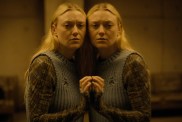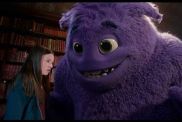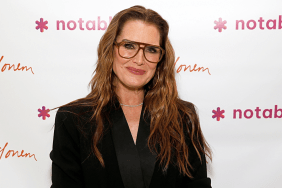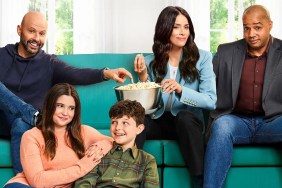When ComingSoon.net spoke to filmmaker Scott Hicks (Shine, Hearts in Atlantis) about his Warner Bros. romantic comedy No Reservations last year, he mentioned an intriguing documentary venture he was preparing for the Toronto Film Festival called Glass: A Portrait of Philip in 12 Parts.
For nearly 18 months, Hicks followed his friend, composer Philip Glass, around with a video camera capturing all aspects of his life and work and creating a far more intimate look at the man than other similar documentaries have ever allowed with their subject matter. It’s a fascinating film as Hicks successfully captures Glass as a family man, delves into his spiritual life and gets some insightful thoughts on how he composes music, while also talking to some of Glass’ filmmaking collaborators like Errol Morris, Martin Scorsese and Woody Allen.
As we learned the last time we spoke, Hicks may be one of the nicest filmmakers you’ll ever have the pleasure of meeting, so we were happy to have him take part in the first-ever Doc Week with this unique documentary experience.
ComingSoon.net: You’ve obviously known Philip Glass for a long time, going back to “Snow Falling on Cedars” ten years ago, so can you talk about the first time you met him?
Hicks: As a lot of filmmakers do, I was actually using a lot of his music to use as temp scores for editing, and I got in touch with his publishing company in case I wanted to actually license the music for the film. Basically, I didn’t end up using it, but they introduced me to Philip and we got on, so a bit of a friendship developed. It was against that backdrop that Jim Keller, Philip’s manager, asked me a couple of years ago if I’d ever thought about the idea of doing a documentary about Philip. I said, “Well, look if Philip will open the doors and let me into his life, I’d love to do it,” because I knew enough about him to know that he’s a very interesting, diverse, and has an enormous amount of energy. His collaborations are sort of extraordinary, so I thought it would be very rich material.
CS: So was Philip aware that his manager was interested in you making a doc about him?
Hicks: I don’t know. It just came out of conversation, so he then was asked whether he was comfortable with the idea, and he had to think about it, but then he said yes.
CS: Having already known a lot about Philip from working with him, you must’ve learned even more while making this movie.
Hicks: Well, I worked with him–he had scored a few commercials that I’d directed as a matter of fact–but up to that point we hadn’t worked together. It was subsequent to that where he did the score for “No Reservations” right in the middle of the period that I was shooting the movie about him, so it was all wheels within wheels by that stage.
CS: Going into this documentary, what were your instincts in terms of bringing the cameras into Philip’s life? Did you have a lot of ideas of what you wanted to cover?
Hicks: I had no idea at all. I just thought I have to find a place to start, and as it turned out… I had no budget to make the film. I wasn’t backed by a studio or a distributor or anybody involved, so after a little while had passed, I thought, “You know, I just really have to start gathering material.” I decided the simplest way to do that was to buy a camera and start shooting the stuff myself, even if it was just to put in the bank later. When I have a proper budget I will order a crew and a cameraperson, and all the rest of it. So I did it, I bought an HD camera and I flew to Nova Scotia where Philip was on vacation with his family, and I started filming. Because it was just me and a sound recordist, it was very low impact. Philip was completely at ease and sort of comfortable and really started almost like a conversation with me off-camera. I was like, “You can’t talk to me; I’m a documentary filmmaker,” but he wasn’t going to let me get away with that. He would talk about things. He would comment on things, and so, to some extent I was sort of drawn into that. The point is that it made the sense of intimacy really real. This was the Philip that I know. This wasn’t just some Philip put on for the camera. This was the real Philip as I had sort of come to know him, and I thought that’s what the purpose of the film was in the end. It was not to explain the theory of Philip Glass’ music. It wasn’t to give a complete account of his career–you can find those things on the internet. The unique thing about this film was the uniqueness of access, so that’s what I decided it had to be, that was the key factor.
CS: You’ve actually made some documentary films earlier in your career, right?
Hicks: Yes, I won an Emmy and a Peabody for my documentary work in the nineties, in the decade prior to making “Shine.” Oddly–I want to say oddly–but it’s a fact that much of the cinema fictional material that I’ve made has been based on true or real stories as well, so you know, it’s a crossover to me between those two disciplines.

CS: How do you approach documentary filmmaking versus doing dramatic features? Is there any kind of overlap between the two?
Hicks: One of the things they have in common is that the process of shooting is really a gathering of raw materials. That seems obvious in documentaries, but it’s also true in dramas, you know, the real movie gets shaped in the editing, that’s where you contemplate exactly what you have and you look for the movie in the material you have, and in documentaries, of course it has to work like that because you can’t predict what’s going to happen in front of your camera, and so it’s a process of constructing the film, giving it the structure that it needs in the edit room.
CS: Can you work with your interview subjects much like you work with actors or is it different?
Hicks: In some documentaries, you can get things to happen over again. You can sort of say, “Oh listen, we didn’t get that, would you mind just running all that again?” I took the decision from the beginning that I had to capture whatever happened, and if I didn’t capture it, then we didn’t have it and that was it. It was not about trying to reconstruct things or trying to set things up to happen in a certain way. I was just going to follow Philip and try to capture the best I could in the circumstances, and that’s really what happened.
CS: Did it take a long time for his family to get comfortable with you being around with your camera filming everything?
Hicks: We didn’t know them when I arrived in Nova Scotia where Philip has a vacation house that he’s had for thirty-five years or more. That’s where I met his family, and I thought, “Yes, I should maybe spend a day or so just getting to know them, not pull the camera out,” and then I thought, “Hey, hold on. You’re just avoiding this, really. You need a film, not to make friends with everybody,” so I pulled the film out and I just started shooting, and people were tremendously at ease. I was just very pleasantly surprised.
CS: Did you have a lot of questions to ask Philip’s sister when she was talking about their family history?
Hicks: Oh yeah, absolutely. I would conduct interviews, but also just shoot candid material which also contained elements of conversation. I felt totally comfortable in the edit of the film, not being a participant because I’m not on camera, but acknowledging to the audience that I am present. I am in the room. I’m not like Flaherty making “Nanook of the North” trying to pretend that I’m not there, the fact is that people know there is a camera in the room.
CS: When did you get the idea to break up the film into twelve distinct parts?
Hicks: Well, all along I was wracking my brain of how this was going to work, and people wanted to know too. You’re talking to potential distributors and they say, “Well, what’s the structure?” You’re always thinking about that part of it, and I was thinking, “Is it a day in the life, or a year, and a day with Philip Glass?” The numbers of the hourglass and the calendar just kept going through my head, which is twelve, so when I was editing, I was editing it deliberately in chapter, because there were so many events that allowed us to glimpse elements of the past and Philip’s history, but through the present, what he was doing today. It it turned out that we really ended up with twelve sort of compartments. Well, okay, here it is, it’s twelve parts, music in twelve parts, it’s a portrait in twelve parts, and then just refined it with that in mind.
CS: What kind of conversations did you have with Philip, presumably off-camera, about what you could or couldn’t shoot? Obviously, the spiritual part of his life was something he didn’t want filmed.
Hicks: Well, there were some things he was telling me to film, like the Qigong and that sort of meditation and those various exercises, but he didn’t feel comfortable talking about that himself. Look, we’d be riding along in a car somewhere and Philip would say, “There’s a guy in Mexico you should talk to,” and I’d go, “What? Who?” And he’d say, “Here’s his number. Call him up. I have no idea what he’ll say. I don’t even know if he’ll talk to you,” and that was it. Then it was up to me if I’d follow that through, and of course I did, and always at the end of the road was an interesting story. It was Philip’s way I think of saying, “Look I don’t want to talk about these things, but here are the people you should talk to if you want to know.”

CS: It was really interesting to see how many other filmmakers were willing to talk to you, as well as artist Chuck Close, who probably knows Philip better than anyone else.
Hicks: He was wonderful because he was like a fund of history really, about that whole downtown art scene history from the late sixties on. He and Philip have been friends for forty years, so I also found incredible resonances–Chuck made it evident–between his work, Philip’s work, what was happening at the time, so that was a really sort of interesting episode for me.
CS: Over the eighteen months, how many hours of footage did you wind up shooting?
Hicks: I shot 120 rolls of film, a 120 hours of material, and then with the performances I had multiple cameras, so it’s probably 140, 150 hours of material which is horrifying.
CS: I’ve talked to doc filmmakers recently who’ve shot 500 to 900 hours of footage.
Hicks: Oh, so I don’t feel so bad.
CS: When did know that you had enough and could stop filming and start editing?
Hicks: Well, it was a matter of thinking towards my personal deadline which was the Toronto Film Festival in 2007, since that was Philip’s 70th anniversary. I wanted the film to mark that year, so really it was a matter of working backwards from that, there was a certain point which I had to stop shooting if I was going to finish the film.
CS: Did you edit as you went along or was it hard to do that with the other movie you were making?
Hicks: Didn’t start until very late. I was doing a whole other movie in the middle, and I couldn’t spend very much time obviously on the documentary. An editor I’d worked with in New York, Steve Jess said, “Look, I’d love to work with you on this film,” and I said, “This is what I need. I need somebody else.” So he worked from New York, I was in Adelaide, and we edited across the internet. Each day Steve would upload his cuts, and I would download them in Adelaide, we locked our computers in synch with a piece of software invented in Adelaide where either of us could stop on a frame or advance by three frames or whatever. We would discuss it and Steve would cut more, then I would come to New York. All along the way the film was being financed at that stage, through the commercials I was doing through a company called Independent Media who were really instrumental in getting that film made. Sometimes, that work would bring me to New York and then I could spend time with Philip and I could spend time with Steve Jess. Without the technology being at the level it was, the film would not have been finished, it was really incredible, and then Steve came out to Adelaide and did the final cuts with me.
CS: It’s pretty amazing since there’s also a fifteen-hour time difference between here and there.
Hicks: I know, it was usually me getting up early and catching Steve at the end of his day, but sometimes the other way around.
CS: What was Philip’s reaction after seeing the movie? I think I read somewhere that he liked the movie but wished it wasn’t about him.
Hicks: He said he wished it was about somebody else, which is a very a Philip response, and he elaborated on that a bit recently by saying that it’s a little bit like shaving in the mirror and then having to watch that all day. That’s how entertaining it is, having a film made about you, so that just sort of encapsulates it for me really. Philip is someone whose vanity seems sort of alien to him. He doesn’t seem concerned with it, so really it was a matter of whatever happened, happened and that was the subject of the film.
CS: Has the movie changed at all since Toronto, given that you had a little more time to work on it?
Hicks: I refined it a little, shortened the length basically. It was always running a little bit long, but we had to get it there and get it in a screenable state and then add a little more time to reflect on it and then just turn and rearrange some elements that needed some improvement I thought, which was actually good, seeing it with an audience, it was like a sort of preview screening in a sense, but without the sort of dreaded cards.

CS: Right, I guess you have had to deal with that with all your studio movies.
Hicks: Yeah, they can be useful, but it’s not my favorite thing.
CS: So who would you think is the right audience for the movie? One would expect that fans of Philip’s music would enjoy it, but what about his detractors, because his work does tend to polarize people, even film critics.
Hicks: Actually, for people who have had interest in Philip, it gives a lot of different insight into him. I’ve had people speak to me after screenings of the film saying that although they’re not huge fans of Philip, they’ve actually gotten more of an insight and they want to go back and revisit stuff which is kind of good.
CS: So where do you go from here? You’ve generally taken some time in between your movies while you did commercial work, so do you think you’ll tackle another documentary?
Hicks: I’ve got another movie happening in September or October that I’m shooting in Australia and England, and I’ve just been in London doing some casting for that, looking for locations the shoot and so on, so I’m off on the next visit.
CS: Is that a film you’ve written?
Hicks: No, it’s written by an English writer called Allan Cubitt and it’s with a company called Tiger Aspect who made “Billy Elliot.” They came to me with the script a few years ago. It’s called “Boys are Back in Town”; Clive Owen is playing the lead.
CS: Great, so we won’t have to wait so long to see more movies from you.
Hicks: Absolutely, three movies within two years. I’ve been so touched by people saying, “We haven’t seen something from you in a while,” I didn’t think anybody cared.
CS: Do you see yourself doing any more writing or do you have any screenplays you’ve been working on over the years?
Hicks: Absolutely, I’ve got a couple of things, but it’s always a matter of timing and probably taste and all sorts of things. It’s never easy to interest people in your next idea, it’s kind of bizarre. But yeah, there are definitely things. There’s a book that I have optioned, so there are a couple things in the works.
CS: Has there been any dream project you’ve always wanted to do but just haven’t had the chance to do yet?
Hicks: Yes, yes, there’s just one dream thing. It’s just sitting in the bottom drawer at the moment, I don’t even want to talk about it.
Glass: A Portrait of Philip in 12 Parts opens on Friday, April 18 at the IFC Center in New York. Doc Week will conclude on Friday with the one and only Errol Morris talking about his new documentary, Standard Operating Procedure.









